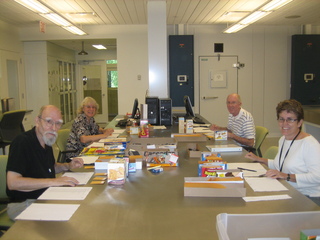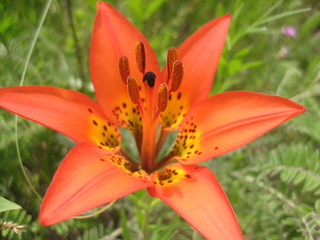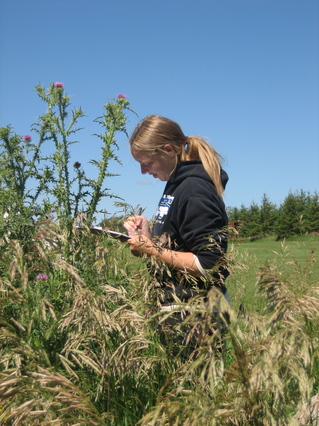|
|
Well, it’s been almost 2 weeks since my last post. How time flies.
Accomplishments:
- Friday the 25th my seed envelopes (of remnant and restoration plants) arrived all sorted from IL. Thanks to my father and all the volunteers for working so hard to get that all done! Great job!
- We finished measuring the first 9 trays of my seed plugs. I think almost eveyone in the team has been helping with this, so my thanks are profuse to you all.
- Laura and I have been working hard to sort all of the purchased seeds into coin envelopes. (30 envelops for each species and source (3 species/3 sources) = 270 envelopes; 20 seeds per envelope = 5,400 seeds).
- Laura and I have also been working on her project together. It’s a lot of fun to visit her remnant sites and see how the floral neighborhoods change over time. Her data’s going to be very exciting!
- Early this week I was given verbal permission to plant my 10×10 meter plots of seeds and plugs at Hegg Lake, Runestone Park, and Bob Mahoney’s. I will hopefully have all the paperwork done soon for that!
- I’ve spent some time working on FNC and pollinator data, but not nearly enough. Hopefully, I’ll be able to devote more time to it soon, especially because I have less than 3 weeks to finish putting together my poster! Eeep!
To Do:
The big goal is to get my plants in the ground ASAP! To that end:
- Today, Laura and I will be marking out my plots.
- We need to finish measuring the 2nd group of 9 flats. It’s particularly important to get the Alive/Dead status for each plug, so I can plan for next week. I hope I can wrangle up more volunteers here, although I know everyone is working hard on their own projects. (Btw, special shout out to Lauren and Hillery who’ve been helping a lot with this!)
- I need to assemble my data to create new envelope labels with the location information for the plots, I’m hoping to get that done and and envelopes labeled by the end of the weekend.
News:
Parents are arriving today for a 4th of July visit! Hopefully they’ll get here in time to enjoy burger night at the K-town bar and grill, but if not they can meet everyone Friday morning.
We will be exploring Starbuck Heritage Days on Saturday (people are free to join us). There will be fireworks at 10 pm.
Some pictures from the weeks news:



Here’s a document that outlines a proposed visor form for the census of Caroline’s Next Generation Rescue experiment.
Proposed protocol for Next Gen Rescue census 2010.docx


June 21, 2010 marked the start of Echinacea flowering in the common garden this year. As of June 28, 2010 113 plants had started producing pollen. Approximately 775 plants will flower this season with a total of 1062 heads. We will be busy keeping track of the first and last day of pollen production per plant. As you can see from the pictures above, the pollinators are back at work, too!
So the weekend is upon us, summer is already beginning to slip away, and aphid abundance is on the rise.
Mine and Lauren’s aphid specialization experiment is still being tweaked to perfection. We set up 5 preliminary aphid transfers on B genotype plants (the offspring of between site echinacea crosses) in order to practice appropriate aphid transfer methods and make sure that we can get aphid establishment on plants that we know aphids are found on (aka to ensure that our transfer methods do not result in aphid squashing and death). This proved perhaps more difficult than expected. I single-handedly destroyed the greater part of several aphid colonies before determining that trying to remove aphids from their leafy homes with a tooth pick was just not going to work. Eventually I settled on disturbing the leaf/gently poking at one aphid (which, it turns out, causes some species of aphid to release an alarm pheromone so all the other aphids on the leaf stop sucking phloem, withdraw their stylets and start moving around). Apparently many Aphis species do not have this alarm pheromone, but when I starting messing with the aphids/the aphids’ leaf they started running around in frantic disarray, so whether or not they release a pheromone, poking them seems to work. After instigating a mass aphid exodus, I attempted to herd several confused individuals onto the flat side of a twist tie. This was also more difficult than you might expect it to be, and was rather time consuming. When we set up our actual experiment we will knock the disturbed aphids into a petri dish, which will be a much more efficient method and will probably result in a significantly less aphid mortality.
We had initially planned on using a single alate (winged) aphid as our population founder, because these are the individuals that would colonize new plants. However, this particular aphid morphology is not nearly as common as the apterous aphids (lacking wings). After conferring with Dave Andow, an entomologist from the U of M, we determined that using apterous aphids is fine, as we are testing plant suitability rather than aphid preference (ie CAN aphids colonize a certain plant, not which plant would a aphid PREFER. And anyway, preference will probably manifest itself somewhat in the form of population success and growth rate). We also discussed the important question of one founder aphid or two. If we can have lots of replicates we could have only one founder. If we are worried about aphid success rate and have fewer replicates, Dave suggested that we have two founders and just record whether one or both birth their aphid babies within the first one or two days of the experiment. Dear readers: Comments or suggestions about aphid founders are encouraged!
One problem: whatever sort of aphid we use, we need to introduce gravid ones to our plants or there will be no population growth whatsoever and our experiment will fail epically. Thus it is now necessary for Lauren and I to be able to identify gravid aphids. Hmm. Apparently this is possible, and this is something we are going to have to figure out before our actual experiment can start. Again: comments or suggestion are encouraged!
I think that covers most of the updates in the glorious and exciting world of me, Lauren, and aphids.
Over and out!
-Hillary
View image
So these are the Stipa that have been collected so far. I’ve labeled a couple of the places on the map.
I was having trouble projecting the data exported from GPS Pathfinder Office (trimble) and noticed that no coordinate system was defined (same issue with the DOQ maps Stuart gave me; the GeoTIFFs didn’t have a spatial definition). The GPS data should be North American 1983 in the Geographic Coordinate System folder (right click on the data in ArcCatalog, hit the XY Coordinate System tab and hit the Select button). The DOQ maps ought to be using the NAD_1983_UTM_Zone_15N from the Projected Coordinate System folder. Dumping all of these files into ArcMap (and a little fiddling) gave me this nice map.
Next plan of attack is to make it work in GPS Pathfinder Office, as it’s much less complicated than ArcGIS.
Here’s a list of plant species that flowered within 2m of a flowering Echinacea plant that we observed last year. The list is sorted by the count of inflorescences we counted. Species in the Asteraceae are highlighted.
Here’s a picture of a Stipa seedling in the Common Garden. I’m about to create a form for entering data on our seedlings. We are debating if we should count and measure each leaf or count leaves and measure the length of just the longest leaf. Most of our time will be spent finding the plants and/or the toothpicks that we put in to mark them. So, taking the measurements of each leaf shouldn’t add that much time. Any thoughts?
Stuart and I did an initial investigation of about 30 locations where Stipa was planted. We found plants at 40-50% of the locations! Caroline, what was your estimate for germination of these seeds?

Josh, Gretel, Hillary, and Ian are also trained on the TopScan to collect the GPS data. The ideal is that the radio signal is at 100% and the designation of the location is described as Fixed – (Float will do and Auto works if you are unable to connect to a radio signal)
Josh and I plan to collect from Hegg Lake and the road adjacent on Monday. In the quest to collect from 300 parent plants, we are likely onto roadsides – where we are trying to stay at least a meter off the road and using plants about 5m apart from each other. Generally, as the black color appears and as the capsule opens around the pointy head, the seeds are ripe and will pop off as you gently pull up the stem containing the seeds.
I plan to be around Sun afternoon and Mon. to finish the collection before starting to cross some plants.
Exciting news! Amy and Hillary found some seedlings at a Hegg Lake plot, the one thats on a hill (the hill with all the phlox on the side) near that blind corner. Anyway, there were nearby flowering plants so its great their reproducing! There were also a couple seedlings found outside the frisbee sized circle area.
here are the pics:

This one is a close up of the shriveled cots (with an achene next to it), can you see it!?!

The seedling finders, working hard!

This was in the morning, getting ready for work:

This is just a prairie lilly (Lilium philadelphicum) that I spotted at Staffenson. First time ever seeing one and I think their beautiful!

Lastly, this is a reminder for me to show Stuart my preliminary data collection sheet:
data table for project.pdf
-Katie
Stipa collection is going pretty well, aside from the Topcon being flaky and not connecting to the data network for improved accuracy (it should be good enough for refinding tags along with the metal detector). We’ve collected from 85 out of the desired 300 so far, with different averages of seeds collected depending on the site. Landfill and Staffenson both had rather high averages, somewhere around 9 or 10 (no math here, just guessing based on what I was entering in the data fields) while some of the scattered remnants were closer to 5 or 6.
As for today, I’ll be out with someone to go search at other sites, hopefully, but the weather is looking a bit questionable today. We’ll see!
|
|







-thumb-320x240-45985.jpg)
-thumb-320x405-45988.jpg)
-thumb-320x240-45993.jpg)
-thumb-320x240-45997.jpg)
-thumb-320x240-46001.jpg)